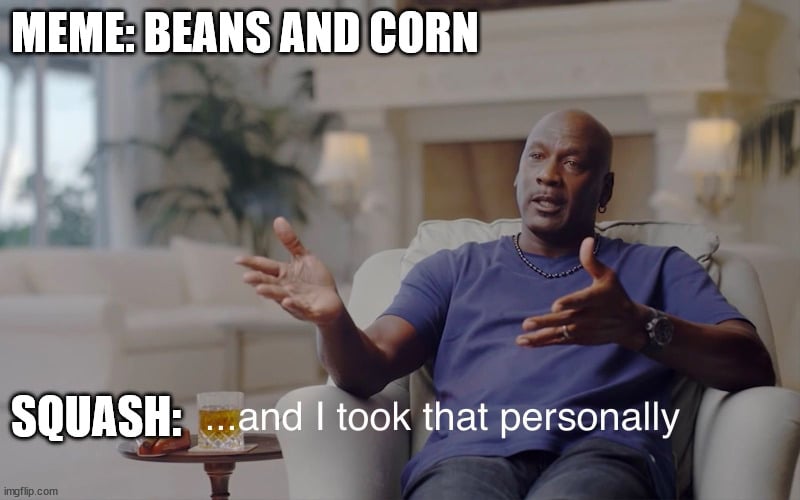- cross-posted to:
- vegancirclejerk@lemmy.world
- cross-posted to:
- vegancirclejerk@lemmy.world
Gotta get those 3 sisters goin’
That’s corn, beans, and squash
What does squash do
Ground cover, reduces evaporation and weeds. Beans climb the corn.
Can only do this with the hardy types that will dry on the vine, tough starchy corn and winter squash like pumpkins though. You try picking squash that will rot, sweet corn, or green beans in a mountain of foliage and vines you’ll just end up ruining the whole thing. Can only harvest at the end of the season.

I release nitrogen back into the atmosphere for the corn after I eat the beans
Why do you think farmers alternate them with corn? Because they get the job done while also being profitable enough to make a living.
Is there any evidence that living legumes make the nitrogen they fix available to other plants nearby? I thought they locked it up in root nodules and it only becomes bioavailable if you chop and drop the legumes so that the nodules break down and release nitrogen into the surrounding soil. Otherwise the legumes are just going to use the nitrogen for their own growth.
This is my understanding too. After the plant dies it can release that nitrogen. While the legume grows, the benefit of nitrogen is negligible and negated by the fact that the legume is competing in the ground for water and other nutrients. The Three Sisters is a nice idea but there is a reason it’s not common practice. See also ‘companion planting’, the astrology of gardening. What plants want most is room to grow roots.
The best thing to do with legumes is till them under before they go to seed, or add them to compost.
Somethin to keep in mind is that it’s a labor intensive harvest and the products aren’t really what we’d want to market. You’d wait until the whole lot of them kind of dies down and harvest winter squash, dry beans, and flint corn then till the remainder back into the soil.
It’s not bad for substinence farming, but you’re not going to get the yields or reasonable market prices with those crops.
Think they talked about this in the most recent season of Clarkson’s Farm. One point they are measuring the availability of nitrogen in the soil and they see that it has increased.
They planted a mixed crop of corn and beans together and it seemed to have a positive benefit.
Did they test the soil and plant a control crop of corn only in nearby similar conditions?
When it comes to gardening I’ve heard countless stories of people trying some intervention and declaring “it works for me” without ever having tested the conditions or using a control. Those kinds of results can be safely ignored as unscientific.
Heck, one thing I’ve noticed with gardening is that even if you attempt to plant a bunch of crops under identical conditions (as best as you can manage) there’s so much variability that you get widely varying yields from one plant to another for completely unknown reasons.
Yes. Well worth watching the episode if you’re interested. Hell, the whole series is very interesting.
Beans and corn
breadgo hand in hand!That’s what beans said to cornbread!!!
Mmmm
Corn and beans 🤤
polyculture intensifies






